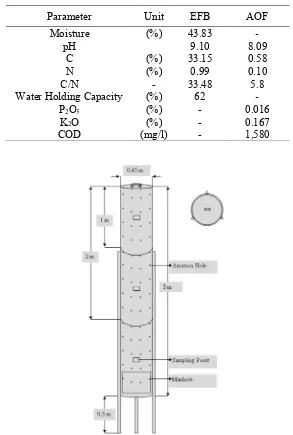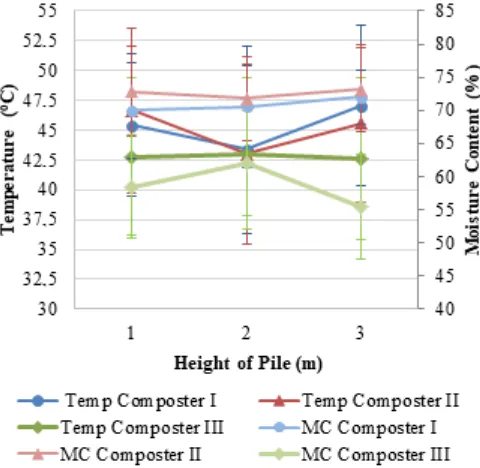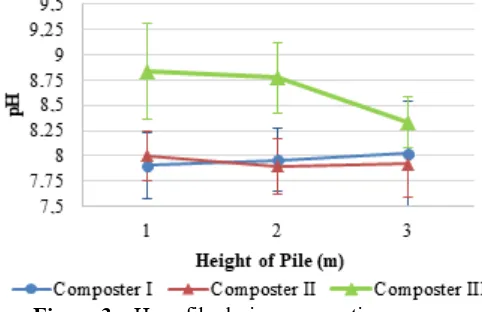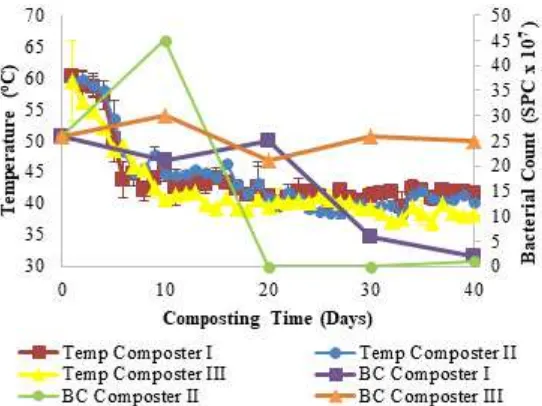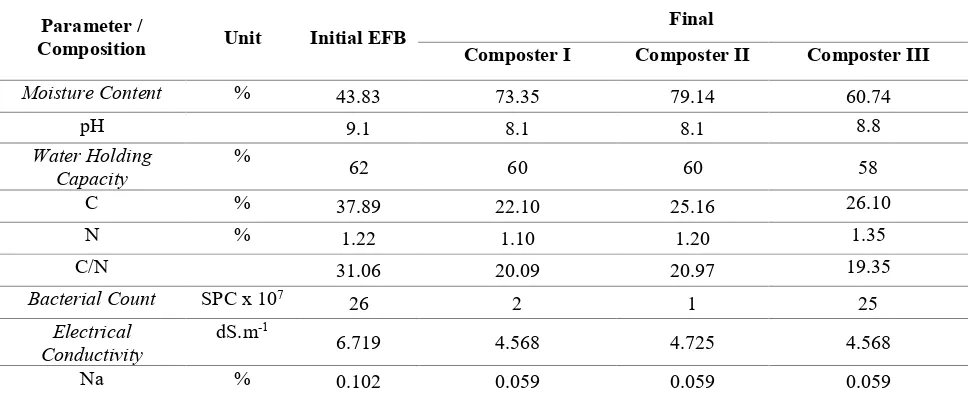IOP Conference Series: Materials Science and Engineering
PAPER • OPEN ACCESS
Composting of empty fruit bunches in the tower
composter – effect of air intake holes
To cite this article: Irvan et al 2018 IOP Conf. Ser.: Mater. Sci. Eng.309 012066
View the article online for updates and enhancements.
Related content
Effect of pieces size of Empty Fruit Bunches (EFB) on composting of EFB mixed with activated liquid organic fertilizer
B Trisakti, P Mhardela, T Husaini et al.
-Effect of Turning Frequency on
Composting of Empty Fruit Bunches Mixed with Activated Liquid Organic Fertilizer
B Trisakti, J Lubis, T Husaini et al.
-Electricity generation from palm oil tree empty fruit bunch (EFB) using dual chamber microbial fuel cell (MFC)
N F Ghazali, N A B N Mahmood, K A Ibrahim et al.
1234567890‘’“”
TALENTA-CEST 2017 IOP Publishing
IOP Conf. Series: Materials Science and Engineering 309 (2018) 012066 doi:10.1088/1757-899X/309/1/012066
Composting of empty fruit bunches in the tower composter –
effect of air intake holes
Irvan1,2, T Husaini1, B Trisakti1,2, F Batubara1, and H Daimon3
1Chemical Engineering Department, Universitas Sumatera Utara, Indonesia
2Sustainable Energy and Biomaterial Center of Excellence, Universitas Sumatera
Utara, Medan, 20155, Indonesia
3Department of Environmental and Life Sciences, Toyohashi University of
Technology, Toyohashi, 441-8580, Japan
*Email: [email protected]; [email protected]
Abstract. The process of composting empty fruit bunches (EFB) by mixing with activated liquid organic fertilizer (ALOF) is an alternative utilization of solid waste generated from palm oil mill. This study aims to find composting techniques of EFB and to obtain degradation data of composting EFB by varying the air intake holes to produce good quality compost. Composting process was carried out by tearing the EFB into four shreds, then put into the tower composter while adding ALOF until it reached the optimum moisture content of 55 - 65%. During the composting process, we maintained moisture content at optimum conditions by adding ALOF. Variations of air intake holes area to the outer surface area of the composter are 0/44.314; 72.39/44.314 and 144.78/44.314 (cm2/cm2). Composting is carried out for forty days, however, based on the result, compost began to mature on the 10th day. The results revealed that there was an influence of air intake holes to the composting process. The best degradation of EFB was obtained on the variation of air intake holes 72.39/44.314 (cm2/cm2), pH 8.1, moisture content 79.14%, water holding capacity 60%, electrical conductivity 4.725 dS/m and C/N ratio 20.97.
1. Introduction
During its operation, besides producing crude palm oil (CPO) and palm kernel, palm oil mill (POM) also produces waste, i.e., solid wastes such as empty fruit bunches (EFB) and palm oil mill effluent (POME). According to Kerdsuwan and Krongkaew, about 20 - 22 tons of EFB are produced from 100 tons of fresh fruit bunches [1]. Indonesia is estimated to produce 90 million metric tons of fresh fruit bunches, resulting in EFB waste about 20.7 million metric tons per year [2]. EFB contains high cellulose, which slightly easy decomposed with a combination of physical, chemical and biological processes [3]. Several studies have been conducted for the processing of EFB into compost by adding additional materials such as animal wastes [4], and by mixing with POME [5]. In this research, the addition was carried out with active organic fertilizer (AOF) that serves as an activator and also maintains the moisture content (MC).
2
1234567890‘’“”
TALENTA-CEST 2017 IOP Publishing
IOP Conf. Series: Materials Science and Engineering 309 (2018) 012066 doi:10.1088/1757-899X/309/1/012066
Methanobacterium and Methanobacillus contained in the effluent are known to form N2 and to add
other macro elements such as phosphate needed by the processing bacteria Bacillus sp, which is achieved by the addition of effective microorganism 4 (EM-4). The purpose of this research is to obtain degradation data of EFB composting using active organic fertilizer inside drum tower composter.
2. Method
2.1. Empty fruit bunches
The raw material of this research was EFB obtained from Palm Oil Mill Sei Mangkei belongs to PTPN III. EFB were torn into 4 (four) shreds. Characteristic of EFB are presented in table 1.
Table 1.Characteristic of EFB and AOF
Parameter Unit EFB AOF
Moisture (%) 43.83 -
pH 9.10 8.09
C (%) 33.15 0.58
N (%) 0.99 0.10
C/N - 33.48 5.8
Water Holding Capacity (%) 62 -
P2O5 (%) - 0.016
K2O (%) - 0.167
COD (mg/l) - 1,580
Figure 1. Scheme and dimension of tower composter
1234567890‘’“”
TALENTA-CEST 2017 IOP Publishing
IOP Conf. Series: Materials Science and Engineering 309 (2018) 012066 doi:10.1088/1757-899X/309/1/012066
Active organic fertilizer, as a source of nutrition and maintenance of moisture content, was obtained from POME processing at Biogas Power Plant, Universitas Sumatera Utara, Medan. Characteristic of AOF used can be seen in table 1.
2.3. Tower composter
Main equipment used was a drum tower composter with a height of 3.00 m and diameter of 0.45 m. The composter was equipped with a sampling hole and an air intake hole. The air intake hole was 1.25 cm in diameter. Scheme and dimension of tower composter can be seen in figure 1.
2.4. Procedure
This research was conducted at Biogas Pilot Plant, Universitas Sumatera Utara, Medan. Composting process was carried out by measuring the total weight of EFB initially, after that inserted into the tower composter, then AOF was added until the moisture content reached 55-65% and maintained at that range during the composting process.
Compost sampling was conducted by taking the compost from sampling holes which were available at each composter height. Temperature measurement was recorded by inserting the thermometer into the hole and performed two times a day, in the morning and afternoon. While, moisture content was measured daily using five grams of compost sample, then pH measurements were performed daily using potentiometric methods. Analysis of C and N were performed every ten days by using Walkley & Black and Kjeldahl method, respectively. Electrical conductivity analysis was carried out every ten days using conductivity meter.Bacterial count analysis was performed every ten days, compost quality analysis was done at the beginning and the end of the composting process.
3. Results and Discussions
3.1. Analysis of temperature and moisture content profiles at any height of compost pile
The most essential parameter to be measured in the composting process is temperature [8]. Figure 2 shows the effect of air intake hole on average temperature during the composting process. The average temperature of composter I, II and III at each tower height of 1, 2 and 3 m were 45.48; 44.92; 45.66
oC, 45.46; 44.61; 45.25 oC and 43.01; 42.93; 42.71oC, respectively.
Figure 2. Profiles of temperature and moisture content at each height composter
4
1234567890‘’“”
TALENTA-CEST 2017 IOP Publishing
IOP Conf. Series: Materials Science and Engineering 309 (2018) 012066 doi:10.1088/1757-899X/309/1/012066
from the height of 1 to 2 m but increased at 3 m, while in composter III the temperature tends to decrease from the height of 1 to 3 m. It can be seen in figure 2, the deeper the compost pile, the higher the temperature. Temperature between composter I and II looks not much different.
Increasing of temperatures in the deeper compost pile was caused by the pile porosity, this was in accordance with those mentioned by Van Ginkel et al. 1999, the mass and heat transfer in the compost pile is significantly influenced by the geometry and the pore size distribution and also composition of the compost material [9]. With the deeper the pile, the porosity in a pile will be smaller, causing the amount of heat generated during the decomposition process was trapped inside the pile.
Moisture content is one of the important factors that must be maintained in the composting process. Baharuddin et al. 2010 stated that the best condition of MC for composting was 55 - 65% [10]. The average MC of composter I, II and III at each height of 1, 2 and 3 m were 68.35, 68.74, 71.99 %; 71.19, 69.84, 73.10 % and 58.09, 61.24, 55.47 %.
As shown in figure 2, the average of moisture content in the composter I and II is almost the same in each height of composters, compared to the moisture content in the composter III. This was due to the liquid that dropped from composter I and II was recycled every day during the composting process, and less air intake hole was used, compared to the composter III, so that moisture content looks much higher. While fluid in composter III was recycled from the bottom of composter at the time of moisture content < 55 % and a number of air intake holes used were more than the number of holes in composter I and II. It caused loss of a large amount of water at vapor state then it can be seen moisture content in composter III was in the range of 55 – 65 % in accordance as reported by Baharuddin et al. 2009. The decrease of average MC value in a pile was also affected by the water evaporation caused by the heat from the pile as reported by Tiquia et al. (2001) where high temperatures in composting process can cause water loss in the vapor state [11].
3.2. Analysis of pH and profiles at any height of compost pile
Figure 3 shows the average pH of composter I, II and III, where the average pH of composter I, II and III at each 1, 2, and 3 m elevations were 7.91, 7.96, 8.02; 8.00, 7.89, 7.92 and 8.83, 8.77, 8.31. The consequence of pH changes during the composting process is due to microbial activity [12, 13].
Figure 3. pH profile during composting process
The average pH between composter I and II looks not much different than composter III, but the highest value among them is pH 8.83 in composter III at the height of 1 m. The increase in pH becomes base condition is good for the composting process, because alkaline conditions can inhibit the growth of pathogens such as fungi that can live in acidic conditions. The addition of aeration holes to the composter helps to reduce the anaerobic phase and helps remove CO2 trapped in the free space
1234567890‘’“”
TALENTA-CEST 2017 IOP Publishing
IOP Conf. Series: Materials Science and Engineering 309 (2018) 012066 doi:10.1088/1757-899X/309/1/012066
3.3. Analysis of compost based on bacterial count and temperature
Microbial activity, quantity, and biomass are parameters that can also be used to explain the composting process [16]. Changes in the number of microbial colonies during the composting process can be seen in Figure 4.
Based on the temperature profile in Fig. 4, two phases are observed during the composting process, namely thermophilic phase (from day 1 to day 20) and mesophilic (day 16 to day 40). The initial value of bacterial count is 26 x 107. At thermophilic phase, the value of bacterial count relatively increased
in all composters. This is due to the availability of nutrients, the mesophilic bacteria that survive in the thermophilic phase were growing. On the 20th day until the 40th, after being in the mesophilic phase,
the number of bacteria slowly begins to decrease as the availability of nutrients decreased. There are currently no reports of acceptable amounts of microbes on mature compost [17] but Atkinson et al. (1996) emphasized that the number of microbes should be low and contain no significant number of pathogens [18].
Figure 4. Bacterial count and average temperature during the composting process
3.4. Analysis of compost based on change of C/N
The C/N ratio is an essential indicator of compost maturity [19]. It was necessary to measure the C/N ratio performed five times during this study as shown in Figure 5.
Figure 5. C/N ratio changes during the composting process
6
1234567890‘’“”
TALENTA-CEST 2017 IOP Publishing
IOP Conf. Series: Materials Science and Engineering 309 (2018) 012066 doi:10.1088/1757-899X/309/1/012066
range 18.13 - 21.47. The decrease in the C/N ratio is due to the decrease in C content during the composting process. This occurs because of the decomposition process of organic matter from the results of microbial activity [20].
3.5. Analysis of compost based on change of electrical conductivity
Electrical conductivity (EC) reflects the level of salinity in a compost product, which suggests the possibility of phytotoxic or phyto-inhibitory effects [21]. The electrical conductivity value changes during composting are shown in Figure 6. The initial value of electrical conductivity compost on composter I, II and III are 4.42, 3.43 and 1.74 dS.m-1, respectively. On day ten until day 20, the value
of compost EC has increased in composter I, II, and III, however, on day 30, the value of EC decreased and then constant at day 40 in the range 4.57 – 4.72 dS.m-1. The decline in EC values during
the composting process is a direct result of increased concentrations of nutrients such as nitrates and nitrites [22] whereas the increase in EC values can be caused by the release of mineral salts such as phosphate and ammonia ions through the decomposition of organic substances [21]. The final EC value obtained after the composting process was 3.73 dS.m-1. Characteristic of final compost is shown
in table 2.
Figure 6. Electrical conductivity changes during the composting process
Table 2. Characteristic of final compost
Parameter /
Composition Unit Initial EFB
Final
Composter I Composter II Composter III
1234567890‘’“”
TALENTA-CEST 2017 IOP Publishing
IOP Conf. Series: Materials Science and Engineering 309 (2018) 012066 doi:10.1088/1757-899X/309/1/012066
CaO % 1.759 2.043 2.043 2.043
The conclusions obtained from research are as follows:
1. EFB with the mixture of AOF as a microbial source, the nutrient source, and moisture content buffer were proven to produce compost about ten days.
2. The height of the compost pile affected the composting process as shown on some parameters that have been analyzed
3. The composting process using drum tower composter successfully reached thermophilic temperature.
4. The quality of compost on the 40th day was not so much different from compost produced on
the 10th day, as indicated by the change in C/N value from 21.47 to 20.97 on composter II.
Acknowledgment
This research was supported by Hibah Penelitian Talenta Universitas Sumatera Utara No: 5338/UN5.1.R/PPM/2017, May 22nd, 2017.
References
[1] Kerdsuwan S, Krongkaew L 2011 Renewable Energy – Trends and Applications, Intech [2] Ishola M M, Isroi, Taherzadeh M J 2014 Bioresour. Technol. 165 9-12
[3] Alkarimiah R, Rahman RA 2014 Int. J. of Eng. Sci. Innov. Tech.3 132-145
[4] Ghazali M R, Mutalib S A, Abdullah A 2016 AIP Conference Proceedings,1784 030042 [5] Baharuddin A S, Wakisaka M, Shirai Y, Abd-Aziz S, Abdul Rahman A N, Hassan, M A 2009
Int. J. Agri. Res. 4 69-78
[6] Irvan, Trisakti B, Sosanty F and Tomiuchi Y 2016, Asian J. Chem. 28 377-380 [7] Kyuma K, 2005 Paddy Soil Science, Kyoto University Press and Trans Pacific Press
[8] Saiidi S, Hasani M, Hashemi J, Amini-rad M 2012 The 1th International and the 4th National
Congress on Recycling of Organic Waste in Agrilcultural, Isfahan-Iran
[9] Van Ginkel J T, Raats P A C, Van Haneghem I A 1999 Netherlands J. Agri. Sci.47 105-121 [10] Baharuddin A S, Lim S H, Md Yusof M Z, Rahman N A A, Md Shah U K, Hassan M A,
Wakisaka M, Sakai K, Shirai Y 2010 African J. Biotech. 9 2427-2436
[11] Tiquia S M, Wan J H C, Judy H.C. Wan, Tam N F Y 2001 Proc. Biochem. 37 1057-1065 [12] Kananam W, Suksaroj T T, Suksaroj C 2011 Sci. Asia 37 17-23
[13] Sundberg C, Smars S, Jonsson H 2004 Bioresour Tech.95 145-150 [14] Liu H, Cai L 2014 BioResources9 4862-4872
[15] Sekman E, Top S, Varank G, Bilgili M S 2011 Freseniu Env. Bulletin20 1841-1852 [16] Tiquia S M, Sonia M 2005 J. Appl. Microb.99 816-828
[17] Ogefere H O, Ogbimi A O, Omoregie R 2010 Malaysian J. Microb. 6 25-29 [18] Atkinson C F, Jones D D, Gauthier J J 1996 Poultry Sci. 75 608-617
8
1234567890‘’“”
TALENTA-CEST 2017 IOP Publishing
IOP Conf. Series: Materials Science and Engineering 309 (2018) 012066 doi:10.1088/1757-899X/309/1/012066
[20] Hock L S, Baharuddin A S, Ahmad M N, Md Shah U K, Rahman N A A, Abd-Aziz S, Hassan M A, Shirai Y 2009 Australian J. Basic Appl. Sci.3 2809-2816
[21] Gao M, Liang F, Yu A, Li B, Yang L 2009 Chemosphere78 614-619
